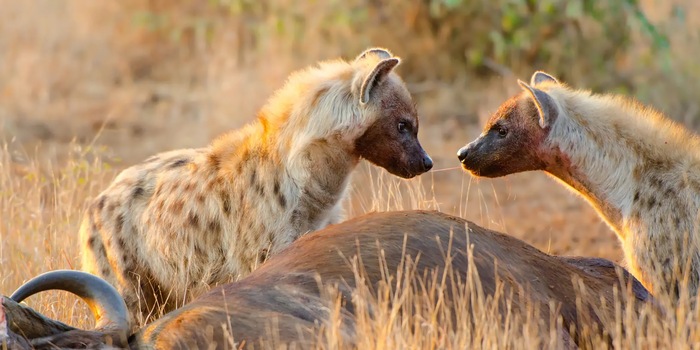
Hyena flat share with potential prey
Hyenas are persistent hunters with a complex family life. However, the fact that they share their dens with unusual partners is new.
The Lewa Nature Reserve in northern Kenya is considered one of the most beautiful and best-protected wildlife reserves in the country - and also attracts scientists who conduct studies here. Marc Dupuis-Désormeaux from York University in Toronto and his team, for example, wanted to investigate the role of spotted hyenas (Crocuta crocuta) in the region. To this end, the working group observed the underground burrows of the predators and came across a surprising community, as they write in the "African Journal of Ecology".
Between 2016 and 2019, at least two family groups of hyenas were known to share their dens with potential prey: As evidenced by camera traps, two porcupines (Hystrix cristata) and three warthogs (Phacochoerus africanus) used one den alongside seven hyenas. The other den was occupied by eleven hyenas, two porcupines and six warthogs. A cohabitation that has never before been recorded in Africa.
The animals all came through the same entrance and sometimes only missed each other by two minutes. However, Dupuis-Désormeaux and co. suspect that they did not spend time together in the same sleeping den, but stayed in different areas of the branched den system. However, this cannot be resolved without excavating the burrows, which the biologists refrained from doing.
Hyenas do eat warthogs and porcupines (the latter, however, rather rarely due to the unpleasant weaponry of the animals), as faecal samples in the vicinity of hyena dens have shown. However, this was not the case for the two shared dens: Here, the researchers detected no remains of either species in the faecal products - possibly a sign of divergent dietary preferences between the hyena clans.
Inside the caves, surprise attacks as a group are hardly possible anyway and defenders have a clear advantage. The animals also use the area at different times: Warthogs are mainly active during the day, while the porcupines and hyenas mainly leave the den at night. The porcupines may also have benefited from the predators' prey: they like to gnaw on bones, which the hyenas sometimes bring home with them.
After 2019, however, the observations came to an end: the caravans had apparently disbanded and have not been sighted since. The reasons for this are unknown.
Spectrum of science
We are partners of Spektrum der Wissenschaft and want to make well-founded information more accessible to you. Follow Spektrum der Wissenschaft if you like the articles.
[[small:]]
Cover image: © BirdImages / Getty Images / iStock (detail) Spotted hyenas are skilful and persistent hunters that also take prey from other predators. Sometimes, however, they remain peaceful.
Experts from science and research report on the latest findings in their fields – competent, authentic and comprehensible.